C# VB.NET OCR Component Dev Guide¶
Asprise OCR for C#/VB.NET Installation¶
There are two options: install using NuGet or manually download the SDK from asprise.com.
Option 1: NuGet PM> Install-Package asprise-ocr-api¶
First, create a new Visual C#/Visual Basic Windows Form Application project into a solution if you don’t have an existing project.
With this solution opened, open NuGet Package Manager Console, and type the following command:
Install-Package asprise-ocr-apiOnce it is done, you can invoke the OCR demo Form by copying the following code to Program.cs (for C#):
1 2 3 4 5 6 7 8 9 | ...
static class Program { // Program.cs
[STAThread]
static void Main() {
Application.EnableVisualStyles();
Application.SetCompatibleTextRenderingDefault(false);
Application.Run(new asprise_ocr_api.OcrSampleForm());
}
}
|
If you are using Visual Basic .NET, create a new module with a Main Sub and put the VB.NET equivalent of the above code to it.
Click ‘Start’ or press F5 and you should see the the demo UI as shown below. Browse an image, optionally select an output format and click the ‘OCR’ button to perform OCR.
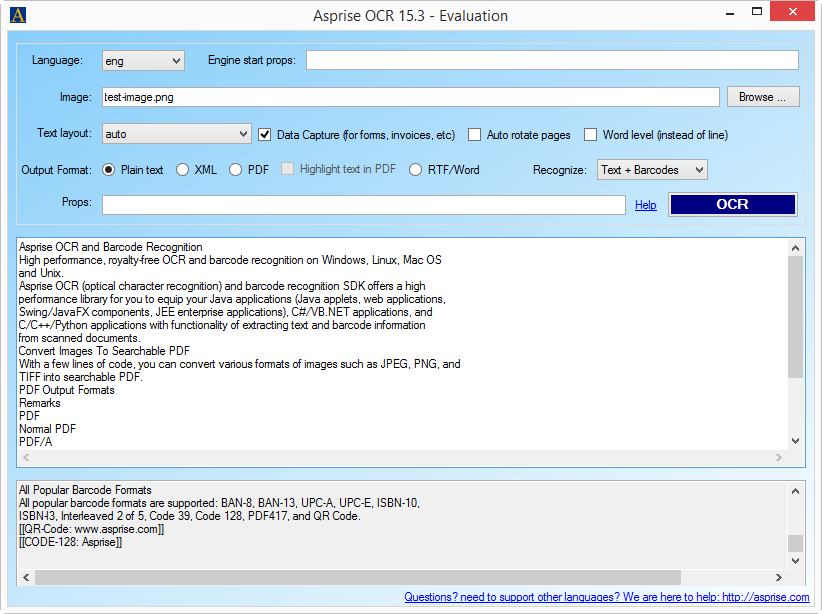
Option 2: Donwload C#/VB.NET OCR SDK from Asprise.com¶
Download a copy of Asprise OCR SDK from www.asprise.com/product/ocr. Simply unzip it to an empty folder.
The file organization of Asprise OCR SDK distribution is as follows:
OCR SDK|--- aocr.dll, aocr_x64.dll [required DLL]|--- sample-projects [.NET API and sample project]+--- images [Sample images]Navigate to sample-projects folder and open the solution: ocr-samples-vs.sln. There are two projects:
asprise-ocr-api: the .NET OCR API
asprise-ocr-api-sample: demo program
Right click on asprise-ocr-api-sample project and “Set as StartUp Project” then hit ‘Start’ button or press F5 and you’ll
see the same UI as shown in last section.
Jump Start¶
The following code demonstrates the basic usage of Asprise OCR:
1 2 3 4 5 6 7 8 9 10 11 | using asprise_ocr_api;
AspriseOCR.SetUp();
AspriseOCR ocr = new AspriseOCR();
ocr.StartEngine("eng", AspriseOCR.SPEED_FASTEST);
string s = ocr.Recognize("C:\\path\\img.jpg", -1, -1, -1, -1, -1, AspriseOCR.RECOGNIZE_TYPE_ALL, AspriseOCR.OUTPUT_FORMAT_PLAINTEXT);
Console.WriteLine("OCR Result: " + s);
// process more images here ...
ocr.StopEngine();
|
The same code in Visual Basic .NET:
1 2 3 4 5 6 7 8 9 10 11 | Imports asprise_ocr_api
Private ocr As AspriseOCR
AspriseOCR.SetUp()
ocr = New AspriseOCR()
ocr.StartEngine("eng", AspriseOCR.SPEED_FASTEST)
Dim s As String = ocr.Recognize("C:\\img.jpg", -1, -1, -1, -1, -1, AspriseOCR.RECOGNIZE_TYPE_ALL, AspriseOCR.OUTPUT_FORMAT_PLAINTEXT)
Console.WriteLine("OCR Result: " & s)
' process more images here ...
ocr.StopEngine()
|
Line 3: performs one-time setup if it has not been done;
Lines 4 & 5: Creates a new Ocr engine that recognizes English in fastest speed setting; The evaluation version is able to recognize English (eng), Spanish (spa), Portuguese (por), German (deu) and French (fra). For other languages, please contact us. The list of languages supported can be found Languages Supported.
Line 7: All the OCR work is done here. The Recognize method of the AspriseOCR class recognizes all the characters and barcodes from the image and output
them as plain text. Other supported output formats are: XML (AspriseOCR.OUTPUT_FORMAT_XML),
searchable PDF (Ocr.OUTPUT_FORMAT_PDF) and user editable RTF (Ocr.OUTPUT_FORMAT_RTF).
Input and Output¶
Asprise OCR supports the following image formats: GIF, PNG, JPEG, TIFF and PDF.
For the sample OCR code in above section, if the input looks like below:
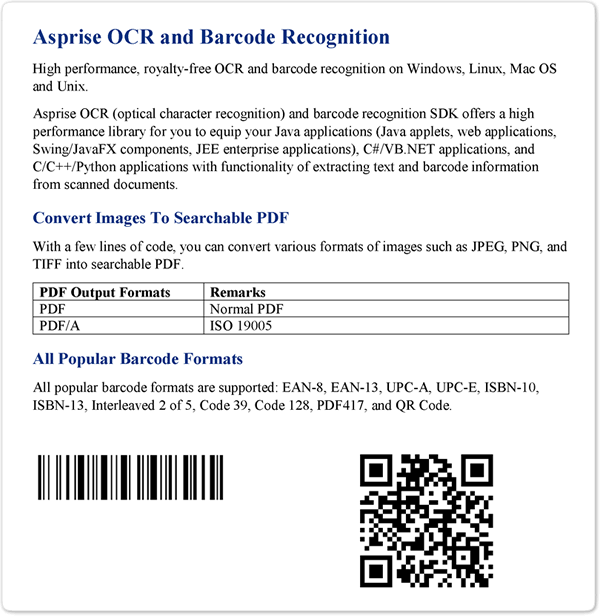
[Download the actual input image here]
The OCR output will be:
Plain-text Format¶
Asprise OCR and Barcode Recognition
High performance, royalty-free OCR and barcode recognition on Windows,
...
ISBN-l3, Interleaved 2 of 5, Code 39, Code 128, PDF417, and QR Code.
[[QR-Code: www.asprise.com]]
[[CODE-128: Asprise]].
The last two lines represents bar code information extract. Note both the format and content of the barcode are enclosed in ‘[[ ]]’ pairs.
XML Format¶
Asprise OCR XML output contains rich information like text coordinates, fonts, confidence level, barcode type, barcode locations, as well as table information (cells with location and row/column info).
Set the output format to OUTPUT_FORMAT_XML, and the you’ll get:
1 2 3 4 5 6 7 8 9 10 11 12 13 14 15 16 17 18 19 20 21 22 | <?xml version="1.0"?>
<?xml-stylesheet type="text/xsl" href="aocr.xsl"?>
<asprise-ocr input="test-image.png">
<page no="0" width="2400" height="3200" words="126" confidence="92" time-taken="1.928">
<block id="1e" type="text" subtype="line" x="320" y="248" width="1176" height="63" words="5" confidence="93" font-name="Times_New_Roman" font-size="66" font-bold="0" font-italic="0" font-serif="1" baseline="297" xheight="34" ascent="15" descent="-15">Asprise OCR and Barcode Recognition</block>
<block id="1f" type="text" subtype="line" x="320" y="360" width="1725" height="43" words="13" confidence="92" font-name="Times_New_Roman" font-size="45" font-bold="0" font-italic="0" font-serif="1" baseline="394" xheight="23" ascent="11" descent="-10">High performance, royalty-free OCR and barcode recognition on Windows, Linux, Mac OS</block>
<!-- ... -->
<table id="4" x="320" y="1083" width="1766" height="169" rows="3" cols="2" cells="6" words="10" confidence="91">
<cell id="3" x="320" y="1083" width="563" height="57" row="0" col="0" rowspan="1" colspan="1">
<block id="29" type="text" subtype="line" x="343" y="1098" width="429" height="41" words="3" confidence="92" font-name="Times_New_Roman" font-size="41" font-bold="0" font-italic="0" font-serif="1" baseline="1130" xheight="23" ascent="9" descent="-8">PDF Output Formats</block>
</cell>
<cell id="5" x="883" y="1083" width="1203" height="57" row="0" col="1" rowspan="1" colspan="1">
<block id="2a" type="text" subtype="line" x="905" y="1099" width="181" height="32" words="1" confidence="90" font-name="Times_New_Roman" font-size="37" font-bold="0" font-italic="0" font-serif="1" baseline="1130" xheight="22" ascent="9" descent="-5">Remarks</block>
</cell>
<cell id="6" x="320" y="1140" width="563" height="55" row="1" col="0" rowspan="1" colspan="1">
<block id="2b" type="text" subtype="line" x="343" y="1154" width="83" height="31" words="1" confidence="93" font-name="Times_New_Roman" font-size="43" font-bold="0" font-italic="0" font-serif="1" baseline="1185" xheight="21" ascent="10" descent="-10">PDF</block>
</cell>
<!-- ... -->
<block id="1" type="barcode" subtype="QR-Code" x="1397" y="1647" width="441" height="441" confidence="1">www.asprise.com</block>
<block id="2" type="barcode" subtype="CODE-128" x="348" y="1651" width="583" height="147" confidence="148">Asprise</block>
</page>
</asprise-ocr>
|
You may view the result in a browser. To do so, you need to save the XML into a file (e.g. ocr-result.xml) and download http://asprise.com/ocr/files/schema/15/aocr.xsl to the same folder as the XML file. Then open the XML file using IE, Firefox or Safari (Chrome doesn’t support this):

Searchable PDF Format¶
If you set the output format as OUTPUT_FORMAT_PDF, you need to specify the target PDF output file as following:
1 2 3 | ocr.Recognize("C:\\test-image.png", -1, -1, -1, -1, -1,
Ocr.RECOGNIZE_TYPE_ALL, Ocr.OUTPUT_FORMAT_PDF,
"PROP_PDF_OUTPUT_FILE=ocr-result.pdf|PROP_PDF_OUTPUT_TEXT_VISIBLE=true");
|
In above code, properties are specified in a single string separated by | (with key and value separated by =). Alternatively, you may specify properties separately in pairs:
1 2 3 4 | ocr.Recognize("C:\\test-image.png", -1, -1, -1, -1, -1,
Ocr.RECOGNIZE_TYPE_ALL, Ocr.OUTPUT_FORMAT_PDF,
AspriseOCR.PROP_PDF_OUTPUT_FILE, "ocr-result.pdf",
AspriseOCR.PROP_PDF_OUTPUT_TEXT_VISIBLE, true);
|
For the list of all supported properties, please refer to Asprise OCR Property Summary.
Once the OCR done, you can open the PDF output file with any PDF viewer and perform searches:
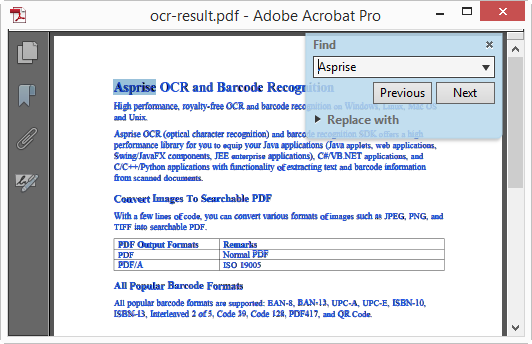
To make the text invisible or transparent, you simply set PROP_PDF_OUTPUT_TEXT_VISIBLE to "false".
Both normal PDF and PDF/A are supported. Please refer to Asprise OCR Property Summary.
Rich Text Format (RTF)¶
Set the output format as OUTPUT_FORMAT_RTF, you can then output .rtf files that can be edited in most word processors (Microsoft Word, Libre Office, TextEdit, etc.).
1 2 3 | ocr.Recognize("C:\\test-image.png", -1, -1, -1, -1, -1,
Ocr.RECOGNIZE_TYPE_ALL, Ocr.OUTPUT_FORMAT_RTF,
"PROP_RTF_OUTPUT_FILE=ocr-result.rtf");
|
Once the OCR done, you can view or edit the RTF file with a word processor:
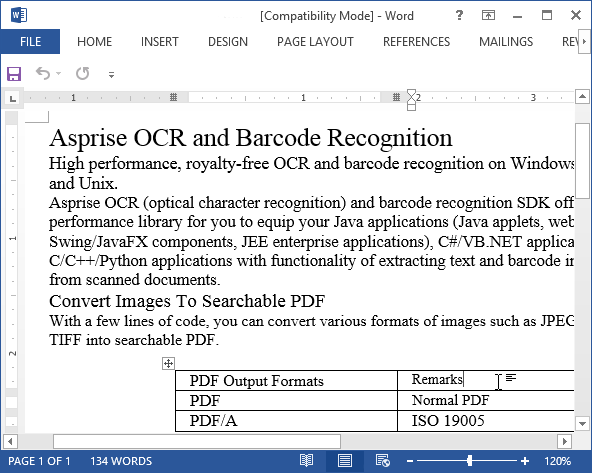
OCR In Action¶
This section covers common OCR tasks.
Recognizes text only or barcode only¶
To save OCR time, you can choose to OCR text or barcode only:
Text only:
string s = ocr.Recognize("C:\\path\\img.jpg", -1, -1, -1, -1, -1,
AspriseOCR.RECOGNIZE_TYPE_TEXT, AspriseOCR.OUTPUT_FORMAT_PLAINTEXT);
Barcode only:
string s = ocr.Recognize("C:\\path\\img.jpg", -1, -1, -1, -1, -1,
AspriseOCR.RECOGNIZE_TYPE_BARCODE, AspriseOCR.OUTPUT_FORMAT_PLAINTEXT);
Perform OCR on part of the image¶
In some cases, you might not want to OCR the whole image. In that case, you can OCR on part of the image to save time:
string s = ocr.Recognize("C:\\path\\img.jpg", -1, 0, 0, 400, 200,
AspriseOCR.RECOGNIZE_TYPE_ALL, AspriseOCR.OUTPUT_FORMAT_PLAINTEXT);
The above code OCR the top left part of the image with width 400 pixels and height 200 pixels.
Perform OCR on multiple input files in one shot¶
You can perform OCR on multiple files in one shot:
string s = ocr.Recognize("C:\\img1.jpg;C:\\img2.png", -1, -1, -1, -1, -1,
AspriseOCR.RECOGNIZE_TYPE_ALL, AspriseOCR.OUTPUT_FORMAT_PLAINTEXT);
Perform OCR on a certain page from the specified TIFF file¶
A TIFF file may contain multiple pages. If you need to recognize only a certain page, you can specify the page number as following:
string s = ocr.Recognize("C:\\img1.tif", 1, -1, -1, -1, -1,
AspriseOCR.RECOGNIZE_TYPE_ALL, AspriseOCR.OUTPUT_FORMAT_PLAINTEXT);
Note 1 means the second page (the page number of the first page is 0). -1 means all pages.
Perform OCR on a PDF input file¶
You use the following method to perform OCR on a PDF input file:
string s = ocr.Recognize("C:\\test.pdf", -1, -1, -1, -1, -1,
AspriseOCR.RECOGNIZE_TYPE_TEXT, AspriseOCR.OUTPUT_FORMAT_PLAINTEXT);
Improve OCR Accuracy¶
Scan in Grayscale with DPI 300¶
If the input images are from scanners, please follow the guidelines below:
Scan at resolution DPI 300 (or 400 for small fonts). Higher DPI may not necessarily result in better accuracy but lower DPI may affect the quality.
Scan in grayscale mode or color mode, but not black/white mode.
Pre-Process Images¶
Image pre-processing can be a great tool to improve OCR accuracy for special images.
Images with very small font¶
Enlarge it:
PROP_IMG_PREPROCESS_TYPE=custom|PROP_IMG_PREPROCESS_CUSTOM_CMDS=scale(2);default()
Images with light text on a dark background¶
Invert it:
PROP_IMG_PREPROCESS_TYPE=custom|PROP_IMG_PREPROCESS_CUSTOM_CMDS=invert();default()
Image operations specified PROP_IMG_PREPROCESS_CUSTOM_CMDS are executed in a
chain. You can chain
many opertions in the command. The list of available operations can be found at Image Pre-processing Related Properties.
Provide Dictionaries or Templates¶
The OCR engine is optimized to recognize human readable words and there are built-in dictionaries and templates. We’ll use an example to find out roles played by dictionaries.
For example, the image below contains two words: abcdopqr abcd0pqr:
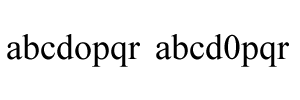
The OCR result with the default settings will be: abcdopqr abchpqr. The OCR engine may have detected abcd0pqr but it discarded it
as it is unlikely a word since there is a number between characters.
Suppose we do consider abcd0pqr as a word. In such case, we can provide our own dictionary file:
abcdopqr
abcd0pqr
Note word entries are separated by line breaks. Save the above content into a file dict.txt and specify it when you start the OCR engine:
AspriseOCR ocr = new AspriseOCR();
ocr.StartEngine("eng", AspriseOCR.SPEED_FASTEST,
"START_PROP_DICT_CUSTOM_DICT_FILE=dict.txt");
string s = ocr.Recognize("image.png", -1, -1, -1, -1, -1,
Ocr.RECOGNIZE_TYPE_ALL, Ocr.OUTPUT_FORMAT_PLAINTEXT);
Note this property must be specified when you call StartEngine. Now, you’ll get the extact text as on the image: abcdopqr abcd0pqr
Alternatively, you can specify the words using a template:
abcd\\npqr
Template entries are separated by line breaks. Save it to a file templates.txt and specify it using :
ocr.StartEngine("eng", AspriseOCR.SPEED_FASTEST,
"START_PROP_DICT_CUSTOM_TEMPLATES_FILE=templates.txt");
Again, the correct result is returned.
The following wildcards are allowed in templates:
|
Any alphbet character |
|
Digit (0-9) |
|
Alphabet or digit |
Multi-threading with Asprise OCR¶
Most of modern computers run on multi-core CPUs. Multi-threading can significantly reduce the runtime by making full use of the processor power. It is easy to do multi-threading with Asprise OCR.
You can implement thread pool pattern by yourself or you can use Microsoft’s default implementation of thread pooling.
Note that each thread must have its own dedicated OCR engine instance.
Software Packaging and Distribution¶
So you have successfully developed your C#/VB.NET applications with Asprise OCR. It’s time to distribute your programs to end users. First, make sure you are an authorized licensee registered with Asprise. To purchase a license, please visit: http://www.asprise.com/product/ocr
You need to distribute aocr.dll along with your own binary code. Dll files should be put into one of the folders in system PATH.








